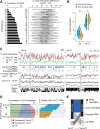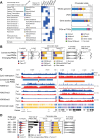Epigenetic dynamics of partially methylated domains in human placenta and trophoblast stem cells
- PMID: 39506688
- PMCID: PMC11542204
- DOI: 10.1186/s12864-024-10986-9
Epigenetic dynamics of partially methylated domains in human placenta and trophoblast stem cells
Abstract
Background: The placenta is essential for nutrient exchange and hormone production between the mother and the developing fetus and serves as an invaluable model for epigenetic research. Most epigenetic studies of the human placenta have used whole placentas from term pregnancies and have identified the presence of partially methylated domains (PMDs). However, the origin of these domains, which are typically absent in most somatic cells, remains unclear in the placental context.
Results: Using whole-genome bisulfite sequencing and analysis of histone H3 modifications, we generated epigenetic profiles of human cytotrophoblasts during the first trimester and at term, as well as human trophoblast stem cells. Our study focused specifically on PMDs. We found that genomic regions likely to form PMDs are resistant to global DNA demethylation during trophectoderm reprogramming, and that PMDs arise through a slow methylation process within condensed chromatin near the nuclear lamina. In addition, we found significant differences in histone H3 modifications between PMDs in cytotrophoblasts and trophoblast stem cells.
Conclusions: Our findings suggest that spatiotemporal genomic features shape megabase-scale DNA methylation patterns, including PMDs, in the human placenta and highlight distinct differences in PMDs between human cytotrophoblasts and trophoblast stem cells. These findings advance our understanding of placental biology and provide a basis for further research into human development and related diseases.
Keywords: Human cytotrophoblasts; Human trophoblast stem cells; Methylomes; Partially methylated domains.
© 2024. The Author(s).
Conflict of interest statement
The authors declare no competing interests.
Figures




Similar articles
-
Ectopic expression of DNMT3L in human trophoblast stem cells restores features of the placental methylome.Cell Stem Cell. 2025 Feb 6;32(2):276-292.e9. doi: 10.1016/j.stem.2024.12.007. Epub 2025 Jan 8. Cell Stem Cell. 2025. PMID: 39788122
-
Isolation and characterisation of a novel trophoblast side-population from first trimester placentae.Reproduction. 2015 Nov;150(5):449-62. doi: 10.1530/REP-14-0646. Epub 2015 Aug 6. Reproduction. 2015. PMID: 26248480
-
The human placenta methylome.Proc Natl Acad Sci U S A. 2013 Apr 9;110(15):6037-42. doi: 10.1073/pnas.1215145110. Epub 2013 Mar 25. Proc Natl Acad Sci U S A. 2013. PMID: 23530188 Free PMC article.
-
Recent progress towards understanding the role of DNA methylation in human placental development.Reproduction. 2016 Jul;152(1):R23-30. doi: 10.1530/REP-16-0014. Epub 2016 Mar 29. Reproduction. 2016. PMID: 27026712 Free PMC article. Review.
-
Conserved and divergent features of trophoblast stem cells.J Mol Endocrinol. 2024 Feb 19;72(4):e230131. doi: 10.1530/JME-23-0131. Print 2024 May 1. J Mol Endocrinol. 2024. PMID: 38276878 Free PMC article. Review.
References
MeSH terms
Substances
LinkOut - more resources
Full Text Sources

